“No virus has been obtained in an absoutely pure state. Not even the washed granules of vaccine virus can be accepted as representing only virus. Therefore it is impossible to say that virus alone is being filtered rather than virus attached to aggregates of protein or particles of degraded cells.”
-Thomas Rivers, Filterable Viruses: A Critical Review
https://www.ncbi.nlm.nih.gov/pmc/articles/PMC374955/
The above statement is from prominent virologist Thomas Rivers in a paper he wrote in 1927 critically reviewing the evidence for filterable “viruses.” This statement came before particles as small as the alleged “viruses” could be seen by the electron microscope as it was not invented until 1931, and the technology did not go into wide use until the 1940's. At the time Rivers wrote this paper, there was no visual evidence for the existence of any “virus.” Virologists would assume that if they passed the fluids of a sick host through a filter that would not allow bacteria to flow through, this action would ensure that only the “virus” particles were present in the aftermath. However, as noted by Rivers, there was more than just the assumed “virus” in the fluids as they could not obtain a pure sample of only the assumed “viral” particles since aggregates of proteins and particles of degraded cells were said to be present within the fluids after filtration. Thus, it has always been known that there are other host materials and contaminants within these “virus” samples even before they could be properly visualized by electron microscopy. However, there was no evidence that any of the unpurified host materials were ever, in fact, “viruses.”
Even after Rivers 1927 admission and as technology progressed, virologists have never obtained a pure sample of any “virus” directly from the fluids. The pictures we see of “viruses” today are of particles created after a cell culture experiment takes place.
For those unfamiliar, cell cultures are a method devised by John Franklin Enders in 1954 as a way of growing “viruses” that is still in use by virologists today. These cultures are the exact opposite of both purification, which means to be free of contaminants, pollutants, and foreign materials, as well as isolation, which means to be separated from everything else in a pure state.
The cell culture method involves taking the host fluids, which have been added to “viral” transport medium (VTM) containing antibiotics, antifungals, fetal cow blood, and other nutrients and chemicals, and mixing it into either an animal or cancer cell maintained within the same materials. This unpurified mixture of host and foreign elements is incubated for days until the cell dies. This death, known as the cytopathogenic effect, is used as indirect evidence that a “virus” is present and accounted for within the fluids originally and that it replicated as a result of the culture. The images we see of “viruses” take place after this process as, according to the CDC, the “viral” particles are unable to be purified, isolated, and visualized without cell culturing.
It has become very clear throughout many conversations with those defending virology that, just as the CDC stated, they cannot demonstrate any evidence showing that the particles claimed to be “viruses” after the cell culture experiment were ever actually present within the fluids of a sick host before experimentation. This existence is an assumption on the part of the virologist as they never check prior to experimentation in order to verify that these particles actually exist within the fluids. As they do not check the fluids prior to the experiment, there is no baseline in order to claim that the “viral” particles were within the fluids and that these particles did, in fact, replicate as a result of the experiment. This is a crucial step not only logically but also scientifically that is entirely missing from every single virology paper. However, those who defend virology will somehow attempt to rationalize that obtaining just the assumed “viral” particles from the fluids alone in order to be characterized, varied, and manipulated prior to experimentation, is not necessary. This illogical thinking was demonstrated in an exchange I had a few months ago with antivaccine activist Jeremy Hammond:
“You assert that the presence of the virus must be proven prior to inoculation in cell culture, which, as I have already explained, is nonsensical since the replication of the virus in cell culture is precisely the means by which scientists determine whether there is a virus present in the sample.”
“Once again, scientists do not have to prove 100% purification of a sample to demonstrate the presence of a virus in that purified sample.”
“What this means is that there may possibly be particles of similar dimension as viruses in the sample, such as exosomes, which are similar in dimension to enveloped viruses and are difficult to separate by centrifugation…”
Jeremy agreed that virologists never check to ensure that the particles claimed to be “viruses” exist within the fluids before the start of their cell culture experiments. He claimed that this step was unnecessary, knowing full well that there are other contaminants and particles within the fluids and that there was no direct visual evidence that the particles seen after cell culturing were ever present within the host to begin with. In fact, in his rebuttal to my article on our conversation, he omitted this crucial step while confirming that there are other contaminants within the sample:
“If a virus is the cause of a patient’s illness, then scientists should be able to extract a sample from the patient, purify that sample by centrifugation to separate viral particles from most of the rest of what’s in the sample, inoculate cell cultures with the resulting supernatant, and observe cytopathic effects and viral replication in inoculated cultures compared to uninoculated controls. They do.”
As can be seen, Hammond went straight from purification to cell culturing without ever supplying a step where electron microscopy is used to verify that the sample was, in fact, free of host material and other contaminants (i.e. purified) and that the assumed “viral” particles were the only ones present within the fluids (i.e. isolated). He admitted that there are other unknown elements within the fluids and yet, like virologists, somehow rationalized that this is unimportant and that virologists can magically distinguish the particles that they had never seen before as the “virus” from a sea of other similar and/or identical ones created after the culture:
“Stone writes that, in addition to exosomes, “there are other particles of a similar size and dimension as ‘viruses’ which can also be mistaken for these entities.” Which is true. But, again, scientists can and do also distinguish between viruses and other particles that might have a virus-like appearance.”
While Hammond did not provide how virologists can magically achieve this distinction from the sea of contaminants, I will unveil the secret. It is called the “point-and-declare” method where virologists randomly pick the particles out from unpurified mixtures that look like their preconceived idea of what a “virus” should look like by highlighting them with tiny arrows.
The virologists then claim that they have found the “viral” culprit from this unpurified mess. However, there is no evidence to show that the chosen particles are the “virus” that they are seeking nor is there any evidence that the particles were ever within the fluids originally before the experiment took place. Thus, it is easy to conclude that the particles blamed as the “viral” culprit are either byproducts of the poisoned cell as it breaks apart and dies or they are nothing more than normal and/or foreign protein aggregates and cell debris that is always present as Rivers noted all the way back in 1927.
While the cell culture experiment is not a valid experiment for many reasons, it is obviously unscientific to start any experiment without confirming the presence of the independent variable (IV).
The IV is the assumed cause that one is investigating to see if it creates a certain effect, known as the dependent variable (DV). In the case of virology, this means that the particles assumed to be the “virus” are the IV that are supposed to be available from the start in order to be varied and manipulated during the experiment. The IV cannot be the end result and a creation of the experiment. Note that the scientific method requires that the independent variable (i.e. the cause; the assumed “viral” particles) exists prior to any experimentation ever taking place.
The only way to ensure that the “viruses” exist prior to the experiment is to purify and isolate the assumed “viral” particles from the fluids of a sick human or animal in order to show that they are present within these samples. This is necessary so that the virologist would be able to know which particle to look for after the cell culture experiment so that they could verify if the particles replicated in their unpurified mess. However, as we saw with the CDC, we are regularly given excuse after excuse as to why this is an impossible task. My favorite example of this comes from Dr. Tom Cowan, who asked a virologist if it was possible to purify and isolate the “virus” particles directly from the fluids without culturing. The virologist answered that this could not be done as there was not enough “virus” within the fluids of a single patient. Dr. Cowan smartly followed up by asking the virologist if there would be enough “virus” within the fluids if the samples of 10 patients were pooled together. The virologist responded that there would still not be enough “virus” to purify and isolate. Dr. Cowan kept upping the ante, making the virologist increasingly uncomfortable in the process, until they reached 10,000 pooled specimens. However, no matter how high Dr. Cowan went, the virologist would not relent in his response that there would not be enough “virus” present within these mixed samples in order to purify and isolate. While he has recounted this story much better than I can on various occasions, here is how Dr. Cowan briefly described this exchange in his excellent book Breaking the Spell:
“When I ask doctors or virologists why they don’t carry out this simple, clear, logical, rational proof to demonstrate the existence of a new virus and show it causes disease, I hear one of two answers. The first is that not enough of the virus is present in any bodily fluid of any sick person to find it in this way. I have even asked scientists whether they would see the virus if the bronchial fluid from 10,000 people with “COVID” were pooled, but the response is the same: “There is not enough virus to find.” This, of course, begs the question: On what theory are we then claiming the virus is making people sick? To this, there is no answer.”
-Dr. Tom Cowan, Breaking the Spell
I have seen similar responses by biologists, virologists, scientists, etc. which have been given to myself and others in exchanges we have had throughout social media. This was the excuse I received from biologist Thomas Baldwin, who studies “pathogenic” plant “viruses” and goes by the Twitter handle Sense_Strand:
Classy.
Another similar response was put forward by Dirk Fausshauer, an associate professor who studied biology and chemistry and was the head of the “Structural Biochemistry” Research Group in the Department of Neurobiology. In a response to another user, Dirk also claimed that there are just not enough “viral” particles to be found before performing the cell culture experiment:
Thus, we can see that the CDC, virologists, biologists, etc. have the perfect excuse which makes their “viral” theory unfalsifiable and entirely pseudoscientific. They simply cannot purify and isolate the assumed “viral” particles from the fluids of a sick human or animal as there are just not enough of these pathogenic particles available to do so no matter how many samples you mix together. It is claimed that the “virus” needs a host cell in order to replicate to a high enough amount so that the virologists can find them, which means a cell culture is the only way. Never mind the fact that the host should be the perfect cell culture and that the body should be teeming with billions, if not trillions, of “viral” particles. Never mind that virologists have admittedly never had any “viruses” available in a pure state to study in order to determine that the cell culture is a viable way to grow a “virus” in the first place. It is somehow seen as ridiculous for anyone to ask for direct proof that the particles seen after cell culture actually exist within the fluids of the host prior to the experiment taking place. How dare we assume that the sample contains impurities, as Rivers suggested, that not only confound the results of any experiment but also make it impossible for the virologists to be able to claim that any particle is their culprit as they can not possibly distinguish between them all. We are to just accept that purification and isolation of the assumed “viral” particles directly from the fluids is not only impossible, but unnecessary. There just are not enough particles available, the contaminants are not important, and cell culture is just how it’s done. Accept it.
However, why should we accept it? The reasoning provided logically makes no sense, especially when looking to their own fiction. If, as according to their theory, “viruses” replicate enough in the body in order to cause disease, there should be an ample amount of “viruses” present within the fluids of a sick human and animal. With the various purification procedures available (centrifugation, filtration, precipitation, etc.), they should be able to purify and isolate the assumed “viral” particles directly from the fluids prior to the experiment ever taking place.
There must be evidence that these “viral” particles are actually within the fluids and, once this is confirmed, that they can be used as a valid independent variable in order to prove pathogenicity via a natural route of “infection.” No excuses. Unfortunately, the excuses keep on coming with no end in sight. As virologists seem to want to continue with the charade that there are not enough “viruses” within the fluids in order to find them prior to experimentation, let's examine exactly why the current defense offered by the protectors of the lie is not only illogical, but also entirely unbelievable based upon their own fictional narrative.
“An estimated 10 nonillion (10 to the 31st power) individual viruses exist on our planet—enough to assign one to every star in the universe 100 million times over.”
https://www.nationalgeographic.com/science/article/factors-allow-viruses-infect-humans-coronavirus
Yes, you read that right. 10 nonillion “viruses” are said to exist on our planet. Sounds like a made-up number, doesn't it? None-illion. However, this is the official number of “viruses” that virologists want us to believe inhabit our environment, surrounding us and making escape impossible. Knowing that one cannot turn around without encountering a “virus,” it should not come as much of a surprise then that, according to the fictional narrative, every human being has a “virome” consisting of 380 trillion “viruses” inside of us at all times. In fact, we are said to be more “virus” than we are human, which appears to go against the narrative that these entities are outside invaders. Rather, it would make more sense that the computer codes of RNA claimed to be “viral” would be of our own genetic material, but they want us to close off the logical parts of our brains and just go with it:
Viruses Can Help Us as Well as Harm Us
Experts are figuring out how to exploit the 380 trillion viruses that make up the human virome
“Biologists estimate that 380 trillion viruses are living on and inside your body right now—10 times the number of bacteria. Some can cause illness, but many simply coexist with you. In late 2019, for example, researchers at the University of Pennsylvania discovered 19 different strains of redondovirus in the respiratory tract; a handful of them were associated with periodontal disease or lung disease, but others could possibly fight respiratory illnesses. Scientists’ rapidly expanding knowledge makes it clear that we are not made up primarily of “human” cells that are occasionally invaded by microbes; our bodies are really superorganisms of cohabitating cells, bacteria, fungi and, most numerous of all, viruses. The latest counts indicate that as much as half of all the biological matter in your body is not human.”
https://www.scientificamerican.com/article/viruses-can-help-us-as-well-as-harm-us/
Does knowing that, according to their own estimates, we are nothing but walking, talking “viruses” muddy the water a bit regarding their narrative that there are not enough “viral” particles within the fluids of a sick human or animal in order to purify and isolate? Of course, they do have the built-in excuse in this fantastical scenario, where they claim that the vast majority of the astronomically inconceivable amounts of “viruses” within us and our environment are harmless, which oddly enough, goes against the very definition of what a “virus” is supposed to be:
However, full disclosure, the definition of what a “virus” actually is seems to be in a constant state of flux, with the original Latin meaning of the word being a “poison” rather than an obligate replication-competent intracellular disease-causing parasite it is known as today.
The definition of what a “virus” is has actually morphed as time went on from its original meaning as a poison to that of a soluble substance. It later was thought of as an enzyme of some sort and eventually became considered as a ferment. From there, the “virus” went on to be viewed as a protein that could survive many chemical processes, and eventually, to a tiny pathogenic microbe. This constantly shifting definition is what happens when there are too many writers in the writing room attempting to get their ideas heard about what the invisible entity is supposed to be:
On the history of early virus research.
“The virus is defined as a biological entity consisting of nucleic acid and protein, as a complex of macromolecules whose genetic material consists of either DNA or RNA and for whose replication suitable host cells must be present. This definition (which is not reproduced here in full) differs markedly from the one that still applied in the early 20th century: the virus was determined as a filterable, submicroscopic pathogen of infectious diseases that could not be cultivated on inanimate culture media. In aetiological disease research, two further characteristics were added, the ability to reproduce in the infected organism and unlimited transferability from one susceptible organism to another. This definition boils down to the verbal manifestation of a specific research practice by explaining the pathogen by its reactions to bacteriological experimental conditions common at the time. We are mainly interested in the transition from the early to the modern virus concept and the role that the development of procedural conditions played in this process.
From the beginning, very different views were taken on the nature of the virus. It was thought of either as a soluble substance, an enzyme, a ferment, high molecular weight proteins that can survive a series of chemical processes without losing their infectivity (i.e. that are organic substances without life of their own), or the virus was thought of as a particularly tiny microbe. Plant pathologists in particular concluded that a soluble substance or an enzyme was a microbe. The history of their subject led them to think primarily of chemical compounds. Animal and human pathologists, who were more closely connected to bacteriology and cytology, favoured the microbial concept.”
https://viroliegyhome.files.wordpress.com/2022/12/lc3bctkethehistoryofearlyvirusresearch_engl.pdf
One thing that should be clear is that, just as virologists love to change the commonly held definitions of words such as they did with purification and isolation, they love to keep us guessing as to what the definition of a “virus” is on any given day. It is also clear that, straight from the official sources, we are supposed to be crawling with these difficult to define “viruses” at all times. According to the official narrative, “viruses” are said to hijack our cells, taking over the cells machinery in order to generate enough copies, eventually exploding thousands of these copies of the invisible pathogenic entity out from a single cell which then spread throughout the body infecting other cells. This process is carried out again and again, resulting in countless copies which supposedly leads to symptoms of disease:
What Is a Virus?
“Their mode of replication is not binary (one divides into two, two divide into four, etc.), as in most other organisms, but occurs as a burst of thousands of virus particles from a single virus over a short time. The number of viruses produced in cell culture or the blood is in the tens of millions per milliliter of media or blood. This mode of replication alone makes viruses unique.”
https://www.ncbi.nlm.nih.gov/pmc/articles/PMC7122971/
While the above source stated tens of millions of these “viral” copies per milliliter of blood, it is, in fact, claimed that just one milliliter of fluid can contain up to 100 million “viruses:”
Expert reaction to questions about COVID-19 and viral load
“We must be more concerned about situations where somebody receives a massive dose of the virus (we have no data on how large that might be but bodily fluids from those infected with other viruses can contain a million, and up to a hundred million viruses per ml), particularly through inhalation.”
https://www.sciencemediacentre.org/expert-reaction-to-questions-about-covid-19-and-viral-load/
This story about how much “virus” is supposedly within a patient with “SARS-COV-2” was confirmed in the below study which looked at the “viral” load in various fluid samples at the height of infection. It was estimated that there were anywhere from 10 thousand to 100 million “viral” copies per milliliter of fluid:
Viral dynamics of SARS-CoV-2 in saliva from infected patients
"Viral loads in saliva were comparable to those in sputum and throat swabs as well, varying from about 10⁴ to 10⁸ copies per mL during the first week of symptoms."
https://www.ncbi.nlm.nih.gov/pmc/articles/PMC7316041/
For an idea as to how much fluid that is, here is a handy comparison chart showing 50 million, 100 million, and 200 million “viruses” on three golden spoons.
Keep in mind, according to the official story, there is no way to purify and isolate the “viruses” from these three golden spoons full of tens to hundreds of millions of these little buggers. Also keep in mind that virologists are using fluid samples much larger than this and yet they still claim that there is just not enough “virus” present to show direct visual evidence of the “virus” within the fluids without culturing. In their fantasy, in order to visualize the “virus,” they must add in VTM, fetal cow blood, and foreign cells for culturing so that the “virus” can replicate enough to the point that they are able to “isolate” and find the “viruses” from the unpurified mess. That doesn't seem very reasonable, does it? It definitely does not, especially as, at peak infection, someone with “SARS-COV-2” is said to contain anywhere from 1 billion to 100 billion “virions:”
The total number and mass of SARS-CoV-2 virions
“Here we use current knowledge on the concentrations of virions in infected individuals to estimate the total number and mass of SARS-CoV-2 virions in an infected person. Although each infected person carries an estimated 1 billion to 100 billion virions during peak infection, their total mass is no more than 0.1 mg.”
https://journals.sagepub.com/doi/full/10.1177/20503121221115053#table2-20503121221115053
It is said that when a person coughs or sneezes, 200 million “viral” particles can be expelled at 50 mph each time:
“What travels 6 feet at up to 50 mph and carries around 200 million particles? A cough and a sneeze.”
https://www.tennessean.com/story/opinion/readers/2014/01/15/correctly-cover-a-cough-sneeze/4456383/
When we throw in the fact that it is claimed that when a person is infectious, they shed 100 billion “virus” particles a day, or 10 million per breath, the inability to find “viruses” within the fluids becomes even more ludicrous:
"When a person is infectious with a virus it is estimated that they may shed one hundred billion virus particles a day — that works out at about 10 million per breath."
https://spectator.us/face-masks-work-note-evidence/
That's a lot of “virus” present in “infected” individuals that somehow cannot be found either within their fluids or hanging out somewhere in the environment. With innumerable amounts of copies of these pathogenic particles within the fluids of a human, how would a virologist ever be able to pick out one “virus” from another? Surely, based on their official story, there will always be more than one “virus” present within any individual at any given time. Just the human gut alone is said to contain 140,000 different species of “viruses” residing within it:
Scientists identify more than 140,000 virus species in the human gut
“Viruses are the most numerous biological entities on the planet. Now researchers at the Wellcome Sanger Institute and EMBL's European Bioinformatics Institute (EMBL-EBI) have identified over 140,000 viral species living in the human gut, more than half of which have never been seen before.”
https://www.sciencedaily.com/releases/2021/02/210218142739.htm
With 380 trillion “viruses” living inside of us at all times and at least 140,000 different species in our guts alone, how many different species of “viruses” are there in total within any given individual? How would any virologist ever know for sure that the particles claimed to be the “virus” that is picked out as the culprit in the EM images after the cell culture experiment is truly the one that they are searching for rather than any of the other various flavors hiding within us? We are supposedly swarming with so many variations of these invisible entities, it would be impossible to separate them all from each other and claim one is pathogenic while another is not. When you factor in that there are admittedly numerous other particles of the same size and density as the assumed “viruses” such as proteins, cell debris, microvesicles, and other microorganisms, the task becomes truly unbelievable. It is quite the conundrum, and one that virologists do not have a logical answer for.
Thus, virologists resort to illogical excuses in that there just isn't enough “virus” present within the fluids to find the “virus” before the cell culture experiment takes place. Again, this should raise the question as to how the cell culture was ever determined as a viable method for growing a “virus” if the “virus” was never observed and studied to begin with. However, they want you to simply ignore this inconvenient plot hole. Virologists contradict their own stories of how we are bursting with “viruses,” and admit every time they use this excuse, that it is not possible to find the particles picked out as their fear-inducing representative within the fluids of a sick human or animal, period. They must create the particles using cell cultured soup. Of course, this method alone will lead to many more particles present after the cell culture as there are numerous additives to the sample. Once the process is over, virologists can then choose their representative from amongst the unpurified fluids containing various other foreign elements. Just the fetal cow blood alone will have its own abundance of microorganisms present.
“However, it is important to note that FBS in human cell cultures may introduce research artifacts; human cells cultured with human sera behave differently from those cultured with FBS [4].”
“Regular FBS contains a large number of extracellular vesicles, some of which are exosomes [18, 19].”
https://www.labome.com/method/Fetal-Bovine-Serum.html
Factor in as well that the animal cell itself, normally from the kidneys of an African green monkey, will add to this unpurified mess as it starts to break apart into further smaller particles as it is progressively starved and poisoned to death in a process known as apoptosis.
It should be crystal clear why virologists cannot find their “virus” directly within the fluids. Even though we are told that we are filled to the brim with “viruses,” the particles chosen to represent the fictional threat do not actually exist within us and must be created using very specific recipes in a lab. Virologists must throw in various additives that proceed to kill the cell so that they can then misinterpret the resulting random particles from amongst the cellular debris as the culprit, when in fact, it was the toxic conditions of the experiment itself which allowed the virologists to conjure up their ideal boogeymen. This has created an unfalsifiable premise in that they are allowed to excuse away the fact that there is no direct visual evidence of the “virus” within the fluids prior to the culture taking place. Virologists get to claim that's just not the way that “viruses” work. The script calls for a host cell that can be poisoned and killed by the virologist in order to create the picturesque masterpieces seen via electron microscopy. For some strange reason, it must be a foreign animal or cancer cell rather than cells from the actual host the sample is taken from in order for the “virus” to replicate and be visualized. This fictional narrative, explaining away the lack of direct evidence of the presence of the “virus” within the host fluids, does not work without this unfalsifiable premise, and if the fraudulent cell culture practice goes away, so too does the “virus.” Thus, the only way the “virus” will ever be observed is after the cell culture experiment takes place, and it will never be seen in a purified and isolated state. This means that the independent variable, that is absolutely essential to the scientific method and must exist in order to be varied and manipulated, does not exist as it should before experimentation. This fact ensures that virology is firmly squared away in the pseudoscience category as their “pathogenic entity” will always remain missing from the very fluids it is supposed to be residing in, no matter how many NONE-illion “viruses” there are claimed to be within and around us.
has a great article examining the lack of a "virus" and the fictional narrative surrounding it with plenty of great resources to turn to as well. took some time to dispel some misconceptions about the discussion on whether "viruses" exist or not. presented a very interesting exchange with "virus expert" Sasha Latypova. took a look at the dangers of cell phone use in her latest vid.





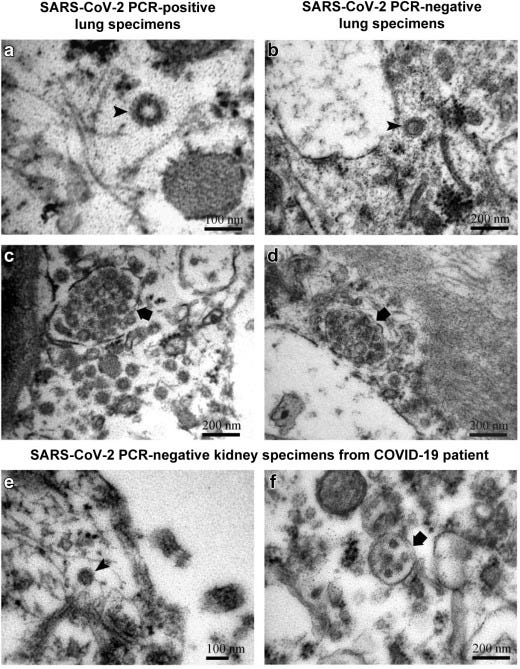

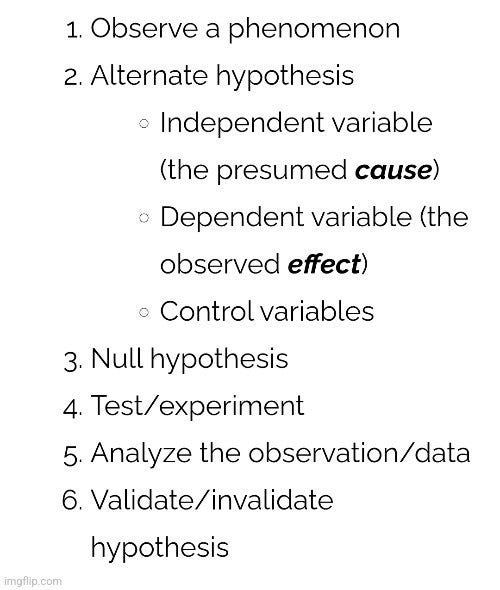
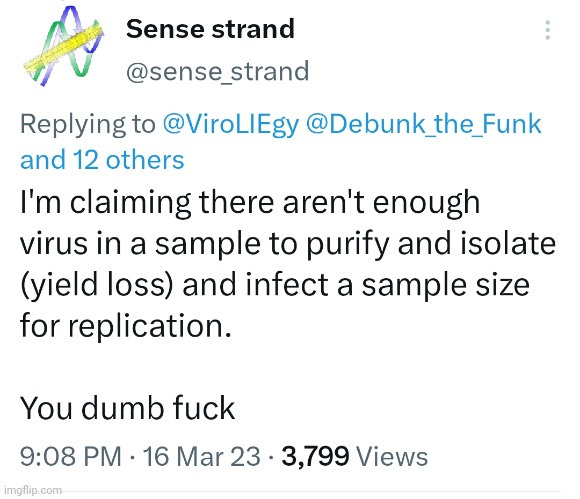
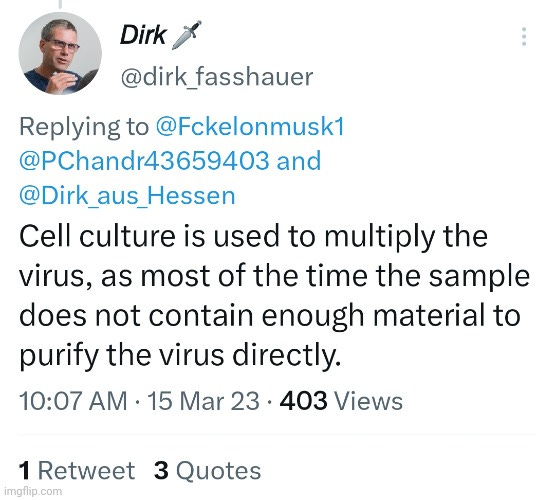

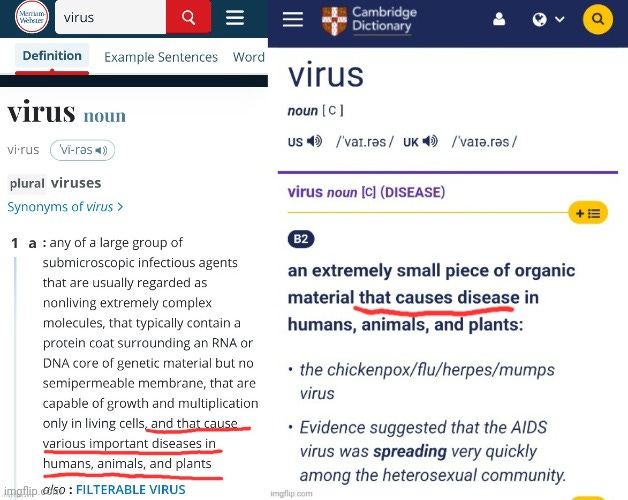


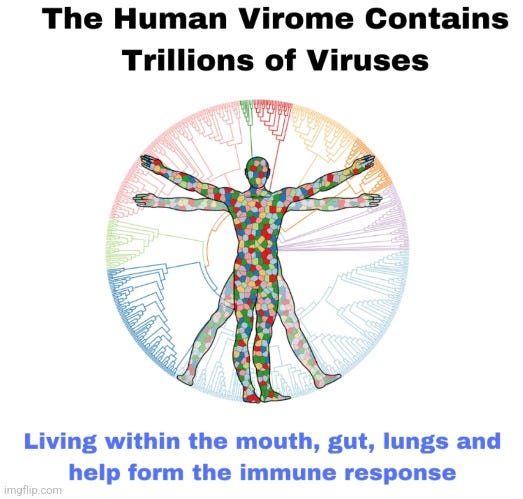




At some point they will start selling the "all viruses are good, we depend on them, they are symbionts, sorry about vaccines all these years, haha"
The ultimate form of damage control: admit everything and blame death scientists from the 20th century.
But the system works and the agencies regulating scientific research are not corrupt at all.
Wow!! One of the best articles that I've read (aside from the amazing Dr. Sam Bailey) that exposes the contradictions (lies/falsehoods) of isolation and purification of "viruses".... As an RN - it's taken me a while to come around on this topic given how we are "educated" and conditioned (brain washed) into believing the established germ theory narrative - but I think I'm finally there.. Thanks so much Mike for this very well written explanation!